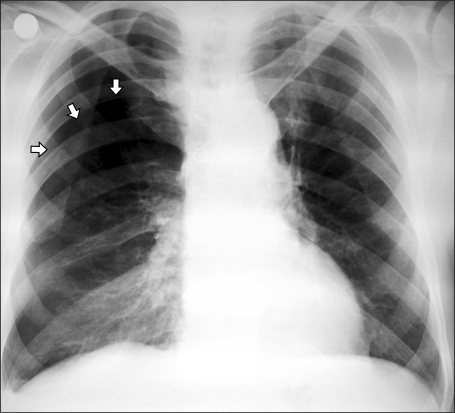Korean J Pain.
2011 Jun;24(2):105-107. 10.3344/kjp.2011.24.2.105.
A Case of Pneumothorax after Phrenic Nerve Block with Guidance of a Nerve Stimulator
- Affiliations
-
- 1Departmant of Anesthesia and Reanimation, Pain Medicine, Boztepe State Hospital of Ordu, Ordu, Turkey. sgbeyaz@gmail.com
- 2Deparmant of Anesthesia and Reanimation, Dicle University Medical School, Diyarbakir, Turkey.
- KMID: 2074006
- DOI: http://doi.org/10.3344/kjp.2011.24.2.105
Abstract
- Hiccups have more than 100 etiologies. The most common etiology has gastrointestinal origins, related mainly to gastric distention and gastroesophageal reflux disease. Intractable hiccups are rare but may present as a severe symptom of various diseases. Hiccups are mostly treated with non-invasive or pharmacological therapies. If these therapies fail, invasive methods should be used. Here, we present a patient on whom we performed a blockage of the phrenic nerve with the guidance of a nerve stimulator. The patient also had pneumothorax as a complication. Three hours after intervention, a tube thoracostomy was performed. One week later, the patient was cured and discharged from the hospital. In conclusion, a stimulator provides the benefit of localizing the phrenic nerve, which leads to diaphragmatic contractions. Patients with thin necks have more risk of pneumothorax during phrenic nerve location.
Figure
Reference
-
1. Ong AM, Tan CS, Foo MW, Kee TY. Gabapentin for intractable hiccups in a patient undergoing peritoneal dialysis. Perit Dial Int. 2008; 28:667–668. PMID: 18981399.
Article2. Schreiber LR, Bowen MR, Mino FA, Craig TJ. Hiccups due to gastroesophageal reflux. South Med J. 1995; 88:217–219. PMID: 7839166.
Article3. Kang KN, Park IK, Suh JH, Leem JG, Shin JW. Ultrasound-guided pulsed radiofrequency lesioning of the phrenic nerve in a patient with intractable hiccup. Korean J Pain. 2010; 23:198–201. PMID: 20830266.
Article4. McAllister RK, McDavid AJ, Meyer TA, Bittenbinder TM. Recurrent persistent hiccups after epidural steroid injection and analgesia with bupivacaine. Anesth Analg. 2005; 100:1834–1836. PMID: 15920222.
Article5. Petroianu G. Idiopathic chronic hiccup (ICH): phrenic nerve block is not the way to go. Anesthesiology. 1998; 89:1284–1285. PMID: 9822029.6. Pooran N, Lee D, Sideridis K. Protracted hiccups due to severe erosive esophagitis: a case series. J Clin Gastroenterol. 2006; 40:183–185. PMID: 16633116.7. Calvo E, Fernández-La Torre F, Brugarolas A. Cervical phrenic nerve block for intractable hiccups in cancer patients. J Natl Cancer Inst. 2002; 94:1175–1176. PMID: 12165648.
Article8. Okuda Y, Kitajima T, Asai T. Use of a nerve stimulator for phrenic nerve block in treatment of hiccups. Anesthesiology. 1998; 88:525–527. PMID: 9477074.
Article9. Lierz P, Felleiter P. Anesthesia as therapy for persistent hiccups. Anesth Analg. 2002; 95:494–495. PMID: 12145080.
Article10. Turkyilmaz A, Eroglu A. Use of baclofen in the treatment of esophageal stent-related hiccups. Ann Thorac Surg. 2008; 85:328–330. PMID: 18154840.
Article11. Gilson I, Busalacchi M. Marijuana for intractable hiccups. Lancet. 1998; 351:267. PMID: 9457104.
Article12. Babacan A, Oztürk E, Kaya K. Relief of chronic refractory hiccups with glossopharyngeal nerve block. Anesth Analg. 1998; 87:980. PMID: 9768811.
Article
- Full Text Links
- Actions
-
Cited
- CITED
-
- Close
- Share
- Similar articles
-
- Phrenic nerve palsy following coracoid infraclavicular brachial plexus block
- Phrenic Nerve Paralysis following Interscalene Bracheal Plexus Block
- The Incidence of Pneumothorax Following Brachial Plexus Block by the Subclavian Perivascular Approach
- Unilateral phrenic nerve block guided by ultrasonography and nerve stimulator for the treatment of hiccup developed after tongue cancer operation: A case report
- Treatment of Postoperative Intractable Hiccup Patient with Unilateral Phrenic Nerve Block: A case report


